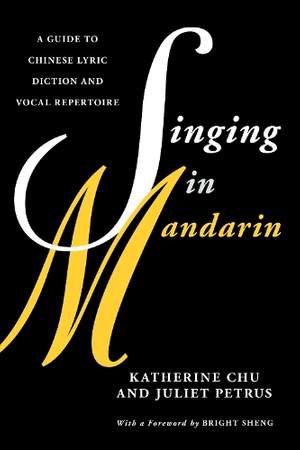
Singing in Mandarin: A Guide to Chinese Lyric Diction and Vocal Repertoire
- Author: Chu, Katherine
- Author: Petrus, Juliet
Book
$54.75Contents
- Part 1: The Fundamentals of Chinese Diction
- Chapter 1: Consonants
- Beginning with consonants and progressing from familiar to unfamiliar sounds, this chapter uses
- comparative diction study to illustrate the differences and commonalities of Chinese diction to
- other, more familiar dictions. Unless readers can already recognize and pronounce Chinese
- characters, Pinyin will be a necessary step in transliterating, as currently it is the most common
- method. Being that the International Phonetic Alphabet (IPA) is a standard method of identifying
- phonemes, the book employs IPA to explain the Pinyin. Even in this early stage of Mandarin
- knowledge, by establishing the important connection between IPA and Pinyin, some students
- may comfortably continue to use the IPA system, while others may eventually progress to using
- only Pinyin as their form of transliteration. In addition to being able to hear all of the sounds
- pronounced by native speakers on the CD, there will be diagrams of tongue position,
- descriptions of how to physically create them, as well as exercises to help the readers acclimate
- themselves to Chinese pronunciation.
- Chapter 2: Vowels
- Continuing the systematic approach from Chapter 1, this chapter thoroughly examines all the
- categories including vowels, vowel clusters and vowel-consonant combination, many of which
- are unique to the study of Chinese diction. It discusses the important subtleties which cannot be
- compared to any other type of lyric diction. The very last section will address the effect that
- certain groups of consonants and semi-vowels have on vowels and vowel clusters that follow
- them.
- Chapter 3: Chinese Semantics, Syntax and Stress
- Once the Chinese diction system is presented and explained in the most scientific manner
- possible, attention can be turned to important properties that characterize this language. Each
- Chinese character is a monosyllable with a stand-alone meaning. Words in Chinese can be
- made up of multiple syllables. Like in English, correct stress while singing in Mandarin is
- essential for comprehension of the lyrics, not only because the tonal aspect of the language is
- completely lost in music, but also because the musical stress begins to superimpose on the
- phrasal stress. This chapter examines how proper stress and inflection restore the syntactic and
- semantic features of the Chinese language.
- Chapter 4: Stylistic Concerns
- The final chapter of Part 1 will be an overview of stylistic issues unique to Chinese diction, such other lyric dictions such as the peculiar and regional property of the final R, and the 'rounding off
- of a syllable' and its effect on legato. There will be also an examination of widely spoken
- dialects such as Cantonese and Taiwanese, and regional accents. These are stylistic elements
- that can transform mere diction into artistry, as they give nuance to interpretation.
- -----------------------------------------
- Part 2: Chinese Vocal Repertoire
- Chapter 5: Overview of Modern Chinese Vocal Literature
- With vocal traditions such as Peking and Kunqu Operas, Chinese vocal music spans centuries
- in Chinese history. Despite this long and rich tradition, the body of work that is applicable to
- classically-trained, lyric singers began emerging in the early 1900s. Modern Chinese vocal
- music mirrors the course of contemporary Chinese history, reflecting political milieu, motivating
- new genres, revolutionizing the language, and assimilating Western influences, which impacted
- the stylistic development of vocal literature. The subsequent chapters are the examination of the
- types of repertoire developed from the last century to the present.
- Chapter 6: Modern Chinese Song Repertoire
- What can be identified as modern repertoire started in the decade after the Revolution of 1911.
- Art songs and folk song arrangements make up a significant part of the type of music accessible
- to the classically-trained singer. However, songs with a popular influence and vocal chamber
- music also make their way to the contemporary recital hall. This chapter will survey these works,
- as well as giving Pinyin and IPA for the most significant pieces. Composers represented will
- include the earliest pioneers such as HUANG Zi, QING Zhu, XIAO Youmei, and ZHAO Yuanren,
- as well as modern disciples such as CHEN Yi, LU Zaiyi, and composers from Hong Kong and
- Taiwan, illustrating their place and contributions to Chinese Art Song, the definition of which
- leads to many fascinating questions and lively debates.
- Chapter 7: Concert and Opera Repertoire
- Concert pieces for voice with orchestra and modern opera represent a recent phenomenon in
- Chinese compositional history. From the very earliest of cantatas to the first Chinese opera in
- the 1930's, the variety of genres fashioned in the Western compositional models in the last two
- decades is well evidenced by the remarkable output from composers, both Western-trained and
- home-grown. Encouraged by the growing number of theaters built and productions staged in
- China, opera is proving to be the epitome of creative expression, attracting many composers to
- turn their attention to writing for this multidisciplinary art form. Composers such as CHEN
- Qigang, CHOU Wen-chung, GUO Wenjing, Bright Sheng, TAN Dun, YE Xiaogang and ZHOU
- Long, help to push these genres forward.



